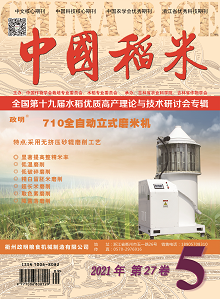To comprehensively and scientifically understand the current situation of rice quality and regional difference of three rice-production superiority areas in China, we collected a total of 5 879 rice samples by grid geographical layout and stratified random sampling from 455 key counties in 17 major rice production provinces of China during 2016—2020, and analyzed 12 quality traits and the ratio of good quality of those samples. The results showed that the ratio of good quality of Chinese rice samples in the past 5 years was 35.96%, the good quality rate of japonica rice(54.02%) was much higher than that of indica rice(27.30%), and the good quality rate of middle-late rice (41.43%) was significantly higher than that of early rice (10.13%). There were variations in the ratio of good quality of rice among different years (26.86% in 2016, 38.30% in 2017, 38.61% in 2018, 38.79% in 2019 and 33.33% in 2020), and the difference of good quality rate among regions was obvious (71.38% in the Northeast Plain, which was significantly higher than 30.83% of the Southeast Coast and 25.78% of the Yangtze River Basin). Northeast China had the highest ratio of good quality (69.65%, 75.13%, 76.87% in Heilongjiang, Jilin and Liaoning, respectively), followed by South China (37.20% in Guangdong and 31.92% in Guangxi), Jianghuai region (31.88% in Jiangsu, 34.88% in Anhui and 33.57% in Henan) and the Yunnan-Guizhou Plateau(31.16% in Guizhou, and 24.76% in Yunnan), and the ratio of good quality in the Sichuan-Chongqing Basin and the Hunan-Jiangsi Plain still need to be improved. In general, various indicators of rice quality in the Northeast Plain were relatively proper, however, the low head rice rate and high chalkiness degree, which are the dominant factors, limited the ratio of good quality of rice in the Yangtze River Basin and the coast of Southeast China. Only 54.82% of the samples' head rice rate reached the good quality standard, the percentages of big three production superiority areas are 84.59%, 47.74%, and 46.17% respectively. Therefore, head rice rate is one of the key factors of regional difference of rice quality in China, and high head rice rate is considered as an important objective to achieve for good quality rice breeding and cultivation in southern China.

